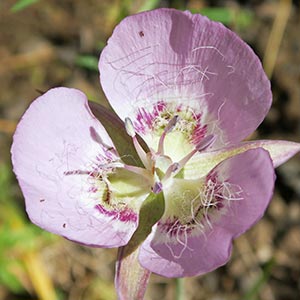Calochortus longebarbatus
Calochortus vestae
long-bearded mariposa lily, long-bearded sego-lily, long-hair star-tulip, longbeard mariposa lily
Coast Range mariposa lily
usually not branching, 1–3 dm, proximal internodes very short;
bulblet in axil of cauline leaf at or below ground surface.
usually branching, straight, 3–5 dm.
single;
basal persistent, 2–3 dm;
blade linear.
basal withering, 1–2 dm;
blade linear.
1–4-flowered.
subumbellate, 1–3-flowered;
bracts 2–5 cm.
erect;
perianth open, campanulate;
sepals ovate-lanceolate, 15–20 mm, apex acuminate;
petals light pink to ± lavender, with red-purple adaxial crescent distal to gland, widely obovate-cuneate, 20–30 mm, not ciliate, with a few long hairs;
glands bordered proximally by ciliate membrane, distally by short hairs;
filaments twice length of anthers;
anther apex obtuse to abruptly short-tipped.
erect;
perianth open, campanulate;
sepals linear-lanceolate, attenuate, 2–3 cm;
petals white to purplish, streaked red to purple proximal to gland, with median red-brown blotch surrounded by pale yellow zone, cuneate to obovate, 3–4 cm, with a few short hairs near gland, apex rounded;
glands ± doubly lunate, not depressed, densely covered with short hairs;
filaments equaling anthers;
anthers oblong-linear, apex obtuse or acute.
erect, 3-winged, ellipsoid to ± globular, 2–3 cm.
erect, linear, angled, 4–7 cm, apex acute.
light brown, irregular.
light beige, flat, 4–6 mm.
= 28.
Calochortus longebarbatus
Calochortus vestae
recent collections of calochortus longebarbatus from oregon exhibit intergradation in the characters that heretofore have been thought to distinguish the following two varieties (k. l. chambers pers. comm.), and their continued recognition may prove unwarranted
Varieties 2 (2 in the flora).
(Discussion copyrighted by Flora of North America; reprinted with permission.)
1. Perianth obconic-campanulate, petals not sharply bent at gland; basal leaves not reddish at base. | var. longebarbatus |
1. Perianth broadly campanulate, petals sharply bent at gland; basal leaves reddish at base. | var. peckii |


